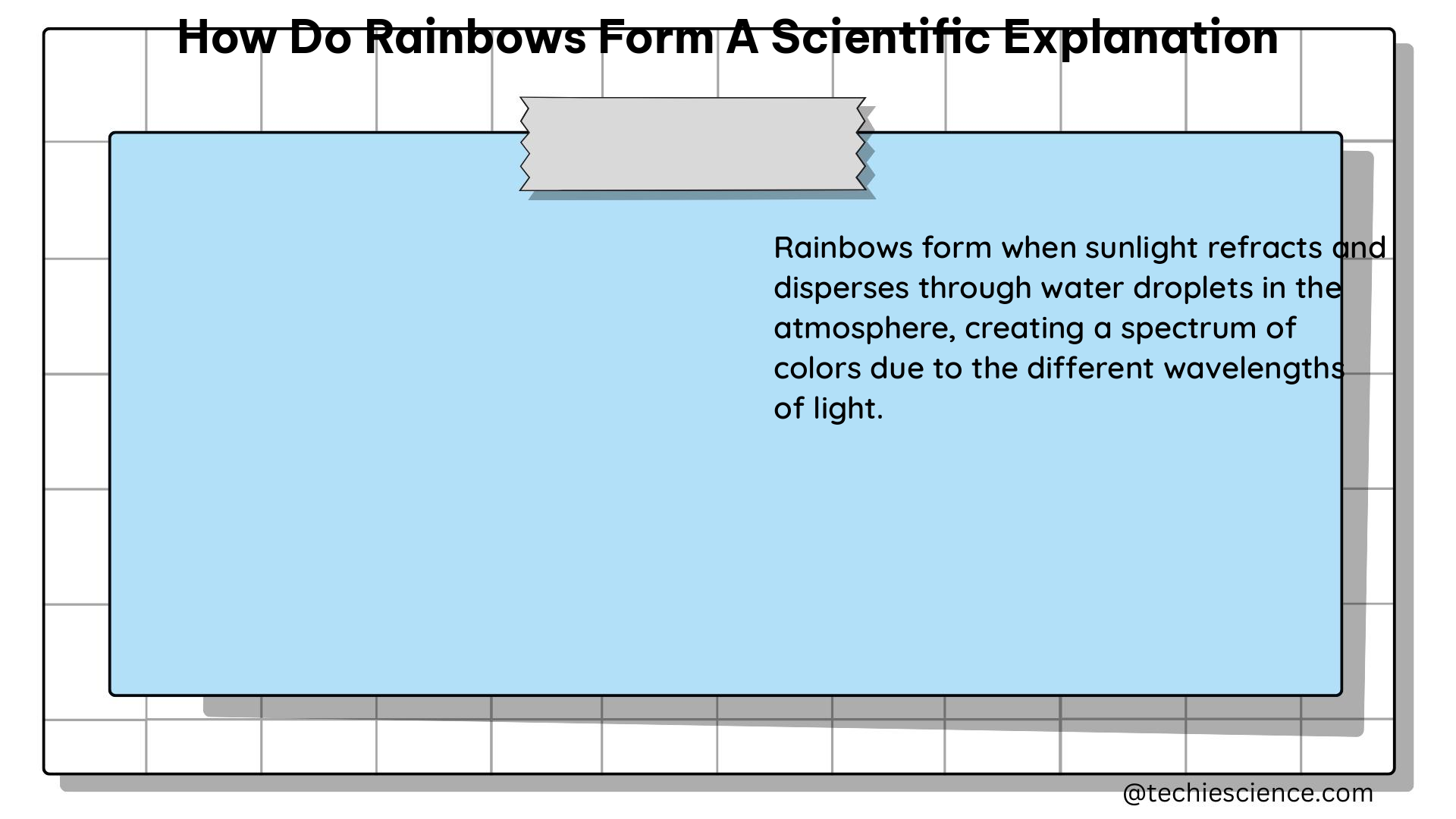Rainbows are a captivating natural phenomenon that have fascinated people for centuries. The formation of rainbows involves a complex interplay of light, water, and atmospheric conditions, which can be explained through the principles of physics. In this comprehensive guide, we will delve into the scientific explanation of how rainbows form, exploring the various measurable and quantifiable data points that contribute to this mesmerizing display of color.
The Angle of Refraction: Bending Light
The formation of a rainbow begins with the refraction of sunlight as it enters a raindrop. When sunlight passes from the air into the water droplet, it slows down and changes direction due to the difference in the density of the two mediums. This change in direction is known as refraction, and it is governed by Snell’s law, which states that the ratio of the sine of the angle of incidence to the sine of the angle of refraction is constant for a given pair of materials.
The angle of refraction depends on the wavelength of light, with shorter wavelengths (such as blue and violet) bending more than longer wavelengths (such as red and orange). This is because the refractive index of water varies slightly with the wavelength of light. For example, the refractive index of water to orange sodium-vapor light is 1.33, while the refractive index of water to violet light is nearly 1.34, and to red light is almost 1.32.
The Angle of Dispersion: Separating Light

As the refracted light travels through the raindrop, it is also dispersed into its component colors. This is because the different wavelengths of light travel at slightly different speeds in water, causing them to bend at different angles. The angle of dispersion, which is the difference in the angle of refraction between the red and violet wavelengths, is approximately two degrees.
This dispersion of light is a crucial step in the formation of a rainbow, as it separates the white sunlight into its constituent colors, creating the familiar spectrum of colors we see in a rainbow.
The Angle of Reflection: Reflecting Light
After being refracted and dispersed, the light can be reflected off the inside surface of the raindrop. The angle of reflection is equal to the angle of incidence, meaning that the reflected light travels in a predetermined path while maintaining the difference in angle of refraction between the various wavelengths.
The angle of reflection, combined with the angle of refraction and dispersion, determines the position of the rainbow in the sky relative to the observer and the sun.
The Position of the Sun: Optimal Viewing Conditions
For an observer to see a rainbow, the sun must be behind them, and at an angle of less than 42 degrees above the horizon. The lower the sun in the sky, the more of an arc of a rainbow the observer will see. This is because the angle of reflection and refraction within the raindrops is such that the light is directed towards the observer’s eyes at a specific angle.
The Size of Raindrops: Affecting the Appearance
The size of the raindrops does not directly affect the geometry of a rainbow, but it can influence the appearance of the rainbow. Smaller water droplets, such as those found in mist or fog, tend to disperse the light more, resulting in a less distinct and more diffuse rainbow. Larger raindrops, on the other hand, can produce a more vivid and well-defined rainbow.
The Colors of the Rainbow: ROYGBIV
A rainbow typically displays seven distinct colors: red, orange, yellow, green, blue, indigo, and violet. This sequence is often remembered by the acronym ROYGBIV. However, it’s important to note that the colors in a rainbow are not a pure spectrum, and there is some mixing and blurring of the colors.
The human eye can perceive a wide range of hues, and the popular idea of a rainbow having seven colors is a simplification of the continuous spectrum of light that is observed.
Conclusion
The formation of rainbows is a complex and fascinating process that involves the refraction, reflection, and dispersion of light by water droplets in the atmosphere. By understanding the measurable and quantifiable data points, such as the angles of refraction, dispersion, and reflection, as well as the position of the sun and the size of raindrops, we can gain a deeper appreciation for this natural wonder.
This comprehensive guide has provided a detailed scientific explanation of how rainbows form, equipping you with the knowledge and understanding to fully appreciate the beauty and complexity of this optical phenomenon.
References
- How are rainbows formed? – Met Office. https://www.metoffice.gov.uk/weather/learn-about/weather/optical-effects/rainbows/how-are-rainbows-formed
- Canon Science Lab | How Do Rainbows Form? https://global.canon/en/technology/s_labo/light/001/02.html
- How Are Rainbows Formed? | Royal Meteorological Society. https://www.rmets.org/metmatters/how-are-rainbows-formed
- Snell’s Law: https://en.wikipedia.org/wiki/Snell%27s_law
- Refractive Index of Water: https://www.refractiveindex.info/?shelf=main&book=H2O&page=Hale

The lambdageeks.com Core SME Team is a group of experienced subject matter experts from diverse scientific and technical fields including Physics, Chemistry, Technology,Electronics & Electrical Engineering, Automotive, Mechanical Engineering. Our team collaborates to create high-quality, well-researched articles on a wide range of science and technology topics for the lambdageeks.com website.
All Our Senior SME are having more than 7 Years of experience in the respective fields . They are either Working Industry Professionals or assocaited With different Universities. Refer Our Authors Page to get to know About our Core SMEs.